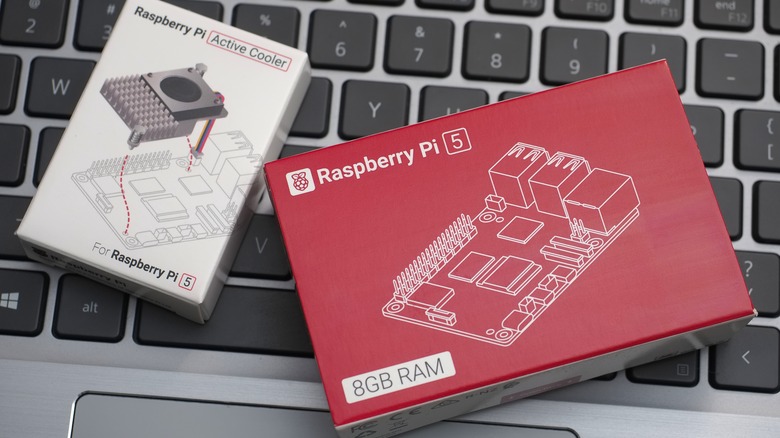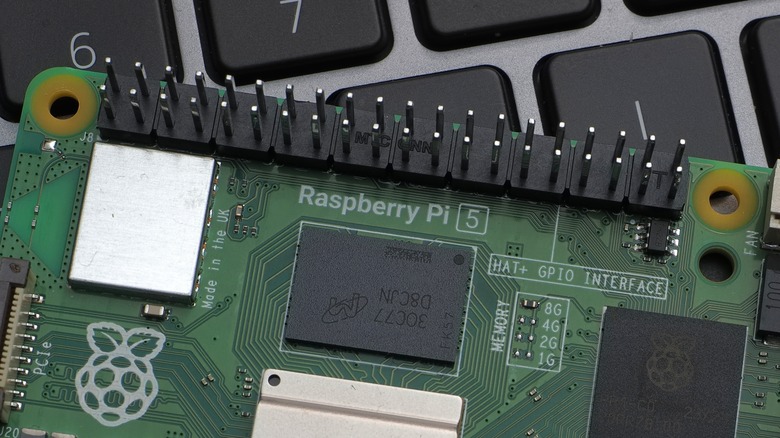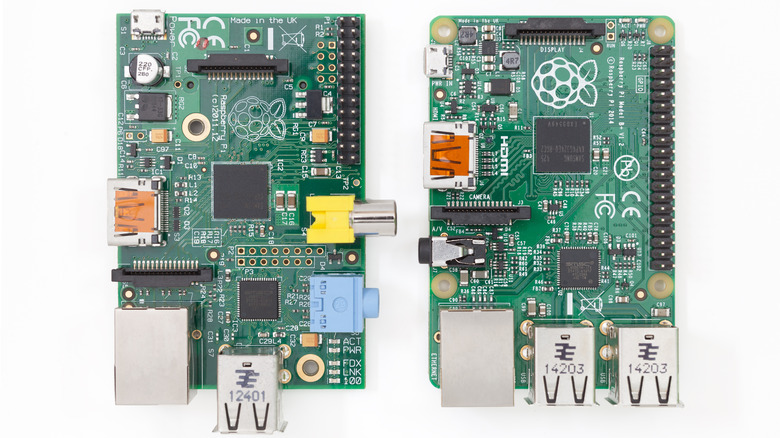How To Tell Which Raspberry Pi You Have
With the Raspberry Pi evolving and releasing different versions regularly, it has become particularly important to know exactly which Pi model you have. Each version has different power requirements, and the last thing you want to do is blow up your board or have it underperform just because you used the wrong power supply. Then, there's the issue of OS compatibility. Some third-party systems like Ubuntu and LibreELEC won't run on older models, so if you plan on using them, you need to know if your board is supported first. You'll also want to identify your exact board model before you go about buying accessories like a Wi-Fi dongle or M.2 SSD storage as your Pi might already have such a feature, or might not yet support it.
Unfortunately, no matter how much you'd like to keep track of which Raspberry Pi models you own, it can be quite a challenge to do so. This is especially true if you love collecting multiple Pi boards and typically buy them used without their original boxes. Add this to the fact that there are over ten versions out there, and it makes it tricky to stay updated with all the models and their features. However, don't worry; there are several methods you can use to determine which Raspberry Pi version your board is.
Method 1: Use the terminal
If you already have your Raspberry Pi installed with the Raspberry Pi OS, there are some terminal commands you can run to know which model you have. All you need to do is access the command line interface (CLI) either by using a display, keyboard, and mouse with your board or remotely connecting to it via SSH. Once you have the CLI pulled up, try any one of these commands:
- cat /proc/cpuinfo | grep Model – This says the full Raspberry Pi board name, complete with the model and the revision.
- cat /sys/firmware/devicetree/base/model – This is another way to get the full Pi board name.
- sudo raspi-config – While this doesn't necessarily output the board name, it opens the Raspberry Pi configuration interface which displays the full board version at the top.
- free -h – This will tell you the memory capacity of your Pi, in case you need that information too.
When running these commands, make sure you're on a Raspberry Pi OS or Raspbian. If you're unsure which OS you're running, type hostnamectl into the command line. This outputs several computer details, including the operating system. You can use this command on Linux systems (yes, the Pi can run on a Linux OS), including Ubuntu, Debian, Fedora, and of course, Raspberry Pi OS/Raspbian.
If, however, you haven't installed any OS on the Pi yet, another way to know its model via the terminal is by simply connecting the board to a monitor and then powering it up without an SD card inserted. Once it boots up, you'll see the Pi name, along with the RAM capacity, at the very top of the screen.
Method 2: Read the label
All of the Raspberry Pi models come with their names printed on the boards. So, if you don't know which version you have and are yet to set up your board with the Raspberry Pi OS, you just need to get your Pi and read the label on the printed circuit board (PCB).
For the regular-sized Raspberry Pis, from the Pi 1 down to the Pi 5, the labels are on the front side where the GPIO pins and ports are. This label will typically tell you the model and the version e.g. Raspberry Pi 3 Model B V1.2. If, however, you only see the name "Raspberry Pi" with a (c)2011.12 printed underneath, this means you have either the Pi 1 Model B or the Pi 1 Model A. The only way you can tell which is which is by inspecting their ports (further detailed in the Method 3 section). Meanwhile, for the Zero versions, the label is on the underside of the board, either in the center or somewhere on the upper left side.
Some Raspberry Pis, however, don't have their PCBs exposed. Such is the case for the Pi 400, which is integrated into a keyboard. As this is the only keyboard-Pi combo released so far, you won't have any trouble identifying it. If you still want to make sure, check the bottom of the keyboard for a sticker that should say "Raspberry Pi 400."
Method 3: Inspect the prominent ports and chips
While the Raspberry Pi boards may look similar, they actually feature different ports and chips upon closer inspection. If you have the Pi on hand, you can identify its model by looking for these features:
- Pi 1 Model B – Two USB ports, ethernet port, RCA connector, 26 GPIO pins, and full-sized SD card slot.
- Pi 1 Model A – Similar to the Pi 1 Model B but with a single USB port and no ethernet port.
- Pi 1 Model B+ – Four USB ports, ethernet port, slimmer audio jack, 40 GPIO pins, and microSD card slot.
- Pi 1 Model A+ – One USB port and no ethernet port, otherwise like the Pi 1 Model B+.
- Pi 2 Model B – Same as the Pi 1 Model B+ but with a big black chip underneath.
- Pi 3 Model B – Like the Pi 1 Model B+ but with a silver chip next to the microSD card slot.
- Pi 3 Model B+ – Similar to the Pi 3 Model B but with a silver chip with the Pi logo in front.
- Pi 3 Model A+ – Like the Pi 3 Model B+ but only one USB port and no ethernet port.
- Pi 4 Model B – Two micro HDMI ports, USB-C power, and four USB ports (two black, two blue).
- Pi 400 – Built into a keyboard.
- Pi 5 – Similar to the Pi 4 but with a power button and PCI express.
- Pi Zero – Smaller in size with a mini HDMI port and a micro USB OTG port.
- Pi Zero W – Similar to the Zero but with a small black chip above the OTG port.
- Pi Zero 2 W – Like the Zero but with a noticeable silver chip beside the CPU.



